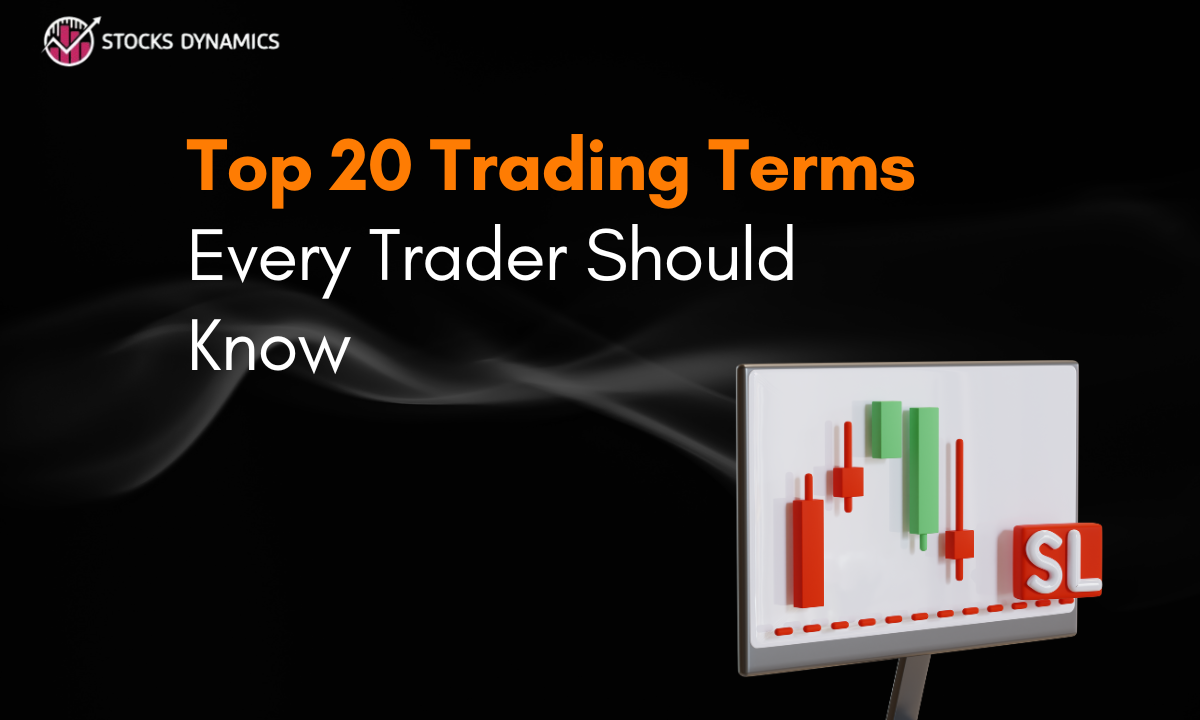Introduction
Trading is a tough job, particularly for a beginner. Mastering the terminology of the financial markets is essential in order to make educated trading decisions, understand trends, and talk with fellow traders in their language. Whether you are a new entrant into the market learning from the ground up or an experienced trader improving your skills, having a good knowledge of trading terminology can be an advantage.
This blog guide will break down the top 20 trading terms that every trader should know, covering fundamental concepts, technical indicators, and market mechanics. By familiarizing yourself with these terms, you will gain the confidence to navigate the financial markets with ease and make your portfolio better. Expanding your trading vocabulary can lead to better execution of trades, improved risk management, and enhanced market confidence. Knowledge is a good asset for trading—take the first step and create the ground to flourish!
Here is the list of must know terms of stock market:
1. Ask Price
The highest price a seller will accept when selling a security. It’s the reverse of the bid price and plays a vital role in determining the bid-ask spread. It’s used by the traders to discover points of entry for the buying orders. The narrow bid-ask spread would generally reflect extensive market interest as well as high liquidity.
2. Bid Price
The maximum price at which an investor purchases an asset. It is one of three parameters employed to fulfill market orders: price, offer price, and bid price. The bid price gets higher and higher as demand rises. Market makers adjust bid prices based on available supply and demand.
3. Spread
The bid-ask spread. A tight spread reflects high liquidity, while a wide spread reflects lower liquidity or greater volatility. Traders want assets with tight spreads to keep transaction costs low. Wide spreads are generally observed in low-volume or highly volatile markets.
4. Liquidity
The degree up to which one can purchase or sell an asset in the marketplace without impacting the price of an asset significantly. Highly liquid instruments are large stocks and currency crosses, while illiquid instruments tend to have more spreads and wider volatility. Smooth transactions and good price discovery enable liquidity.
5. Market Order
An order to buy or sell a security immediately at the prevailing price. Market orders guarantee execution and not price, helpful during chaotic markets. The order is handy during high volumes for rapid entry and exit.
6. Limit Order
A command to purchase or sell a security at a specified price or better. It provides control over entry and exit but may be not filled if the price fails to move to the specified level. It provides more precision in trading. Limit orders prevent unnecessary slippage and deliver price accuracy.
7. Stop-Loss Order
An order to sell a security when it hits a specified price, capping potential losses. It is a useful risk management tool for traders, particularly in unstable markets where the behavior of the price can be erratic. Stop-loss orders assist traders in adhering to their risk management strategy.
8. Take-Profit Order
An instruction to close a trade at a pre-set level of profit. It locks profit and allows the trader to effectively manage their risk-to-reward ratio. Placing take-profit levels avoids impulsive decisions. It aids in promoting disciplined trading without the greed element.
9. Leverage
Borrowing money to expand trade size and potential profit. Leverage amplifies profit but risking increased potential losses. Careful control of risk must be exercised when trading on leverage. Overleveraging will result in quick losses if the market moves against the trade.
10. Margin
The security for opening a leveraged position. Traders need to maintain a sufficient margin level so that they are not margin called and liquidated. Margins are extremely important to learn in order to trade successfully. Effective management of margins avoids liquidation and maximizes capital efficiency.
11. Margin Call
A call for extra cash by a broker when the margin of a trader goes below its targeted value. When a broker does not accommodate, in case of non-accommodation, positions will be liquidated to curtail losses. Maintaining margin values within a favored band is needed to preclude forced withdrawal. Surprise liquidations are prevented through advanced margin monitoring.
12. Short Selling
A strategy where investors short sell, hope the price goes down, and then purchase it at a lower price later to earn a profit. It is a dangerous strategy that demands meticulous analysis of the market. Short selling is utilized in bear markets to profit from declines.
13. Bull Market
A market condition characterized by rising asset prices and firm investor sentiment. Bull markets are typically driven by economic growth, growing earnings, and positive sentiment, offering scope for long positions for investors. Traders mostly adopt buy-and-hold approaches in bull markets.
14. Bear Market
A long-lasting period of decreasing asset prices, typically caused by economic downturns or unfavorable market sentiment. Short selling or hedging is best utilized by traders to weather out bear markets. Bear markets demand careful trading to minimize losses and prevent unnecessary risk.
15. Volatility
The degree of price volatility in a market. High volatility is risk and opportunity for traders as it can result in quick price action and potential profit-taking opportunity. Traders use volatility indicators to identify optimal entry and exit points.
16. Moving Average (MA)
A technical indicator that smooths price data to establish trends. Common types are the Simple Moving Average (SMA) and Exponential Moving Average (EMA). Moving averages help traders identify trend reversals and entry points. Longer moving averages eliminate market noise to give improved analysis.
17. Relative Strength Index (RSI)
A momentum indicator that measures the speed and reversal of price movements. RSI readings above 70 are overbought, and readings below 30 are oversold, signaling potential reversals. RSI helps traders confirm trade signals in conjunction with other indicators.
18. Candlestick Patterns
Visual illustrations of price action within particular time periods. Typical configurations include doji, hammer, and engulfing patterns, which suggest potential reversals of trends. Candlestick patterns are used by traders to forecast market behavior. Knowledge of such patterns enhances trade timing and strategy implementation.
19. Fibonacci Retracement
A technical indicator used to calculate potential support and resistance levels based on significant Fibonacci ratios. Traders use retracement levels to forecast pullbacks and continuation patterns. They are widely used in trend-based trading systems. Fibonacci retracements help traders make more accurate entry and exit decisions.
20. Bollinger Bands
A volatility gauge which is a moving average with overlying and underlining bands. The bands extend and shrink according to changing market volatility. Overbought and oversold positions are detected through Bollinger Bands by the traders. These are effective tools in detecting trend reversals as well as breakouts.
Conclusion
Traders need to have knowledge of the trading terms. Learning these 20 most significant trading terms can greatly assist you in understanding the market conditions, formulating strategies, and taking decisions. Either you are an amateur or an experienced trader, ongoing knowledge accumulation can provide an advantage. Learn more, understand the current trends, and streamline your trading strategy for long-term success. Good luck with your trading!
By including these vital trading terms in your strategy, you’ll be well-equipped to deal with market movement, risk management, and maximizing your investments. Never forget the saying that knowledge is power in trading. The more comfortable you become with these terms and their application in actual-market situations, the better you’ll be at achieving success. Be well-prepared, be disciplined, and trade sensibly! A knowledgeable trader can easily cope with varying market trends and maximize profit chances.

